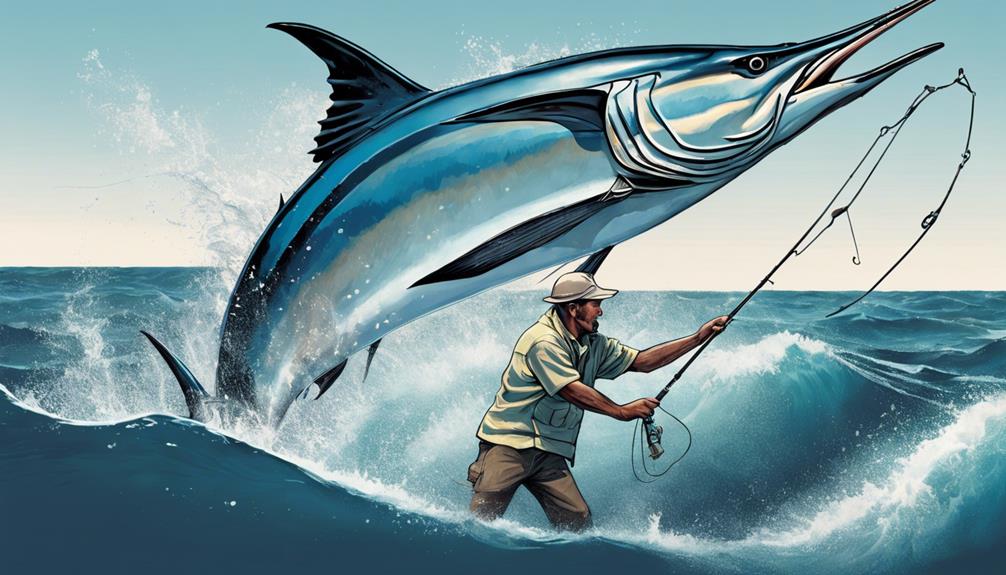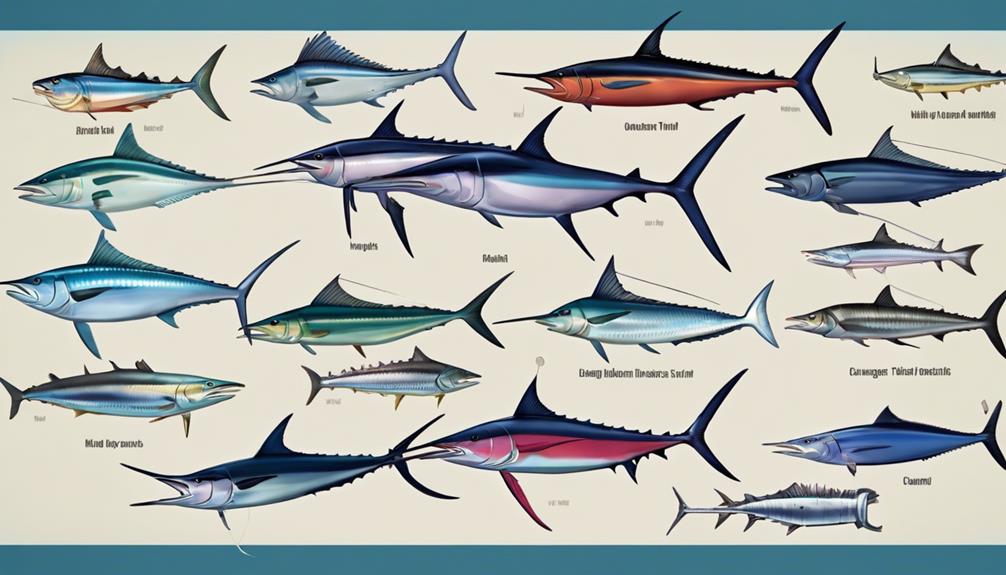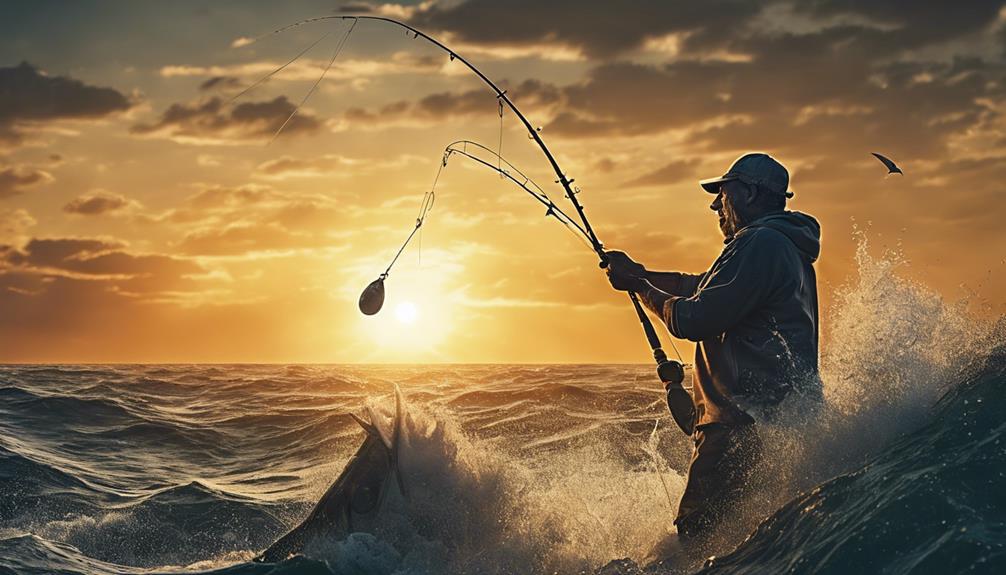Imagine being out on the vast expanse of the open ocean, the salty breeze in your face as you reel in a massive, thrashing catch. But what happens next?
In deep sea fishing, the concept of catch and release plays a vital role in sustainable angling practices. It involves more than just unhooking a fish and tossing it back into the water.
Understanding the intricacies of this method can lead to a fulfilling and responsible fishing experience.
Benefits of Catch and Release
Catch and release in deep-sea fishing offers a sustainable way to enjoy the sport while conserving marine resources. It plays a crucial role in maintaining species diversity by allowing fish populations to thrive. By releasing caught fish back into the ocean, you contribute to the preservation of various species and help prevent overfishing. This practice ensures that future generations of anglers can continue to enjoy the thrill of catching a wide range of fish species.
Moreover, catch and release also enhances angler satisfaction. Instead of focusing solely on the size or quantity of fish caught, this method allows you to appreciate the experience of the hunt and the excitement of the catch. The satisfaction derived from successfully hooking, fighting, and releasing a fish creates a deeper connection to the sport. It's not just about the individual catch but the overall enjoyment of the fishing expedition.
When you engage in catch and release, you become part of a conservation effort that benefits both the marine ecosystem and your own fishing experience. By valuing species diversity and finding fulfillment in the process of fishing, you contribute to the long-term sustainability of deep-sea fishing. Embrace catch and release as a rewarding practice that promotes environmental stewardship and enhances your enjoyment of the sport.
Techniques for Proper Handling
To ensure the well-being of the fish you catch in deep-sea fishing, it's essential to master proper handling techniques. Proper techniques for fish handling not only increase the chances of survival for the fish but also contribute to the sustainability of the marine ecosystem. When handling a fish you intend to release, always wet your hands before touching it. This helps protect the fish's sensitive skin and slime layer, which are essential for its health and protection against infections.
Avoid lifting the fish by its gills or eyes, as this can cause serious harm. Instead, support the fish's weight horizontally with both hands, keeping it close to the water to minimize stress. If you must remove the fish from the water for a quick picture, do so gently and swiftly, ensuring it isn't out of the water for too long. Never squeeze the fish tightly or drop it back into the water from a height, as this can cause internal injuries.
When releasing the fish, hold it in the water and gently move it back and forth to allow water to flow through its gills. Once the fish shows signs of strength and begins to swim away on its own, you can let go. By following these proper handling techniques, you can help ensure the survival of the fish you catch and release.
Importance of Hook Removal
Mastering the proper technique of hook removal is crucial for the well-being of the fish you catch in deep-sea fishing. When removing the hook, you must be gentle and precise to prevent injury and minimize stress on the fish. Here are three key points to consider:
- Gentle Handling: Approach the fish calmly and securely. Hold the fish gently but firmly to prevent excessive thrashing. Avoid putting too much pressure on the fish's body while removing the hook.
- Use Proper Tools: Ensure you have the right tools for hook removal, such as long-nose pliers or dehooking tools. These tools help you remove the hook quickly and efficiently, reducing the time the fish spends out of the water.
- Quick Release: Work swiftly but carefully to remove the hook. The longer the fish is out of the water, the more stressed it becomes. Minimize handling time by having a plan in place before attempting to remove the hook.
Equipment for Safe Release
When preparing for safe release of fish in deep-sea fishing, having the right equipment is essential for minimizing harm and ensuring the fish's well-being. Safe handling of the fish is crucial to increase their chances of survival post-release. To achieve this, it's recommended to use tools such as de-hookers, long-nose pliers, and hook cutters to facilitate the quick and efficient removal of the hook. These tools help in reducing the time the fish spends out of the water, minimizing stress, and improving their chances of a successful release.
In addition to the proper tools, mastering the correct release techniques is vital. Gentle handling of the fish, avoiding excessive squeezing or rough contact, helps prevent injuries and ensures the fish's protective slime layer remains intact. When lifting the fish, support its weight properly and avoid causing harm to its internal organs. Proper techniques also include releasing the fish headfirst into the water to ensure optimal oxygen flow through its gills.
Best Practices for Resuscitation
Ensure successful fish survival post-release by applying proper resuscitation techniques to revive and aid their recovery. When a fish appears lethargic or struggles upon release, prompt intervention can significantly improve its chances of survival.
To enhance the success rates of resuscitation, consider the following best practices:
- Gentle Handling: Handle the fish with care to minimize stress. Support its body properly, avoiding excessive pressure on vital organs. Gentle movements can help prevent additional harm.
- Use of Resuscitation Tools: Carry tools such as dehookers, descenders, and recompression devices to aid in the revival process. Dehooking quickly and efficiently can reduce the time the fish spends out of the water, improving its chances of recovery.
- Proper Methods: Utilize proven resuscitation methods such as gently moving the fish back and forth in the water to aid in water flow through its gills. Ensure the fish is upright and facing into the current to facilitate oxygen exchange.
Conservation Impact of Release
To understand the conservation impact of releasing fish back into the deep sea after catching them, it's crucial to consider the long-term effects on marine ecosystems and fish populations. When fish are caught and released properly, the impact on ecosystems can be minimized. Sustainable fishing practices play a significant role in ensuring the health and balance of marine environments.
By releasing fish back into their natural habitat, you contribute to the preservation of the delicate balance within the ecosystem. When fish are removed from their environment in large numbers, it can disrupt food chains and lead to imbalances in population dynamics. Releasing fish allows them to continue their role in the ecosystem, maintaining the natural order and biodiversity of marine life.
Your efforts in catch and release fishing contribute to sustainability initiatives aimed at conserving fish populations. Releasing fish back into the deep sea gives them the opportunity to reproduce and contribute to the overall population growth. This practice helps in maintaining healthy fish stocks for future generations, ensuring that fishing remains a viable and sustainable activity.
Ethics and Guidelines

For ethical deep sea fishing practices, it's important to adhere to established guidelines. When engaging in catch and release fishing, there are specific ethical considerations and responsible fishing practices that should be followed to ensure the well-being of the marine environment.
Here are three key points to consider:
- Ethical Considerations: Always prioritize the welfare of the fish. Handle them with care, minimizing stress and injury during the catch and release process. Use appropriate gear and techniques to increase the chances of survival post-release. It's essential to treat the fish respectfully and humanely.
- Conservation Efforts: Engage in responsible fishing practices that support conservation efforts. Release fish promptly and avoid overfishing in certain areas. By practicing catch and release, you contribute to the sustainability of fish populations and help maintain the ecological balance of the marine ecosystem.
- Sustainable Practices: Choose gear and equipment that are environmentally friendly and minimize harm to marine life. Educate yourself on the best practices for catch and release fishing to ensure that your actions align with sustainable principles. By adopting sustainable practices, you can enjoy the sport of deep sea fishing while preserving the ocean's delicate biodiversity.
Research on Release Survival
When considering the effectiveness of catch and release practices, understanding the research on release survival rates becomes crucial. Research findings on release success and survival rates provide valuable insights into the impact of catch and release fishing on fish populations. Studies have shown that the survival rates of released fish can vary depending on various factors such as fishing techniques, handling practices, hook types, and environmental conditions.
Research on release survival has indicated that using barbless hooks can significantly increase the chances of fish survival. Barbless hooks cause less damage during hook removal, reducing stress and injury to the fish. Additionally, proper handling techniques, such as minimizing air exposure and avoiding removing the fish from the water for extended periods, can also improve release success.
Moreover, studies have highlighted that mortality rates are higher for fish that are deeply hooked or have injuries from the hooking process. It's essential for anglers to be equipped with the knowledge and tools to safely release fish, ensuring their survival after being caught. By following best practices supported by research, anglers can contribute to sustainable fishing practices and conservation efforts.
Frequently Asked Questions
What Are the Potential Risks for Fish When Participating in Catch and Release Fishing?
When you participate in catch and release fishing, remember that fish stress is a major concern. The way you handle the fish, especially during hook removal, greatly impacts their survival.
Proper techniques like minimizing air exposure and quick hook removal help reduce stress and increase the chances of the fish surviving after being released back into the water.
Being mindful of these factors can make a significant difference in the well-being of the fish.
How Can Anglers Ensure They Are Practicing Catch and Release Fishing in a Sustainable Manner?
To practice catch and release fishing sustainably, make sure to handle fish with care, use barbless hooks, and minimize fight time. Conservation education is key in understanding proper techniques.
Always have the right tools, like pliers, to safely remove hooks. Avoid excessive handling and keep fish in the water as much as possible.
Are There Specific Regulations or Laws in Place Regarding Catch and Release Fishing in Certain Areas?
In certain areas, fishing regulations exist to protect marine biodiversity. As an angler, it's your responsibility to know and follow these rules to ensure sustainable fishing practices.
By practicing catch and release in a responsible manner, you contribute to the conservation of fish populations and their habitats.
Be informed about the specific laws in place in the area where you're fishing to help maintain a healthy balance in the ecosystem.
What Are Some Common Mistakes Anglers Make When Releasing Fish Back Into the Ocean?
When releasing fish back into the ocean, remember to handle them properly and remove hooks carefully. Common mistakes anglers make include not supporting the fish's body, tossing them back in too roughly, or taking too long to release them.
By being gentle and efficient, you can give the fish a better chance of survival after being caught.
How Can Anglers Educate Themselves and Others About the Importance of Catch and Release Fishing for Marine Conservation Efforts?
To educate others on catch and release fishing for marine conservation, start with educational outreach. Engage the public by sharing the importance of sustainable practices. Raise conservation awareness by discussing the benefits of releasing fish.
Conclusion
In conclusion, catch and release in deep sea fishing is a valuable practice that helps conserve fish populations and promote sustainable fishing practices.
By following proper techniques for handling, hook removal, and release, anglers can ensure the survival of the fish they catch.
Remember to always prioritize the well-being of the fish and consider the impact of your actions on the marine ecosystem.
Keep practicing catch and release to help protect our oceans for future generations to enjoy.



